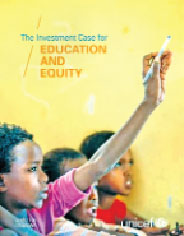
"Everyone has the right to education. Education shall be free, at least in the elementary and fundamental stages." — Article 26, Universal Declaration of Human Rights
Education is a powerful instrument to break the cycle of poverty and disadvantage for individuals, families, societies and countries. Numerous studies have proved the impact of education on individual incomes and economic growth.
On average, one more year of education brings a 10 per cent increase in an individual's earnings. In addition, higher education levels lead to higher economic growth for the nation as a whole. As the Education for All (EFA) Global Monitoring Report 2013/4 states: "If all students in low-income countries left school with basic reading skills, 171 million people could be lifted out of poverty, which would be equivalent to a 12 per cent cut in world poverty." Further analyses highlight several important points. First, the effect of education on poverty is generally higher in lower-income countries. This means that investing in education in developing contexts is both efficient and good economics as well as the correct thing to do from a rights-based perspective. In addition, poverty reduction is faster in countries with greater income equality, which itself is related to education equity. Finally, women's education tends to bring higher economic returns than men's education, even though women are often the most excluded. This pleads for focused attention on enrolling and retaining both girls and boys from all population groups, including the most marginalised.
The document Investment Case for Education and Equity examines the challenges facing education today, including the growing school-age populations in the world's poorest countries. This UNICEF publication establishes three essential ingredients to revive progress in increasing the number of children who can go to school and learn: more funding for education, an equitable approach to resource allocation and more efficient spending on quality education.
The publication is divided into four chapters. Chapter-1 examines the far-reaching impact of education, economically and socially. This chapter makes the case for investment in education by presenting concrete evidence of the positive impact education has on individuals, families and nations, both in terms of national income, economic growth and poverty reduction and in human development outcomes such as health, fertility, women's empowerment, risk management, individual and community resilience, civic engagement and increased tolerance. Equity and education are highly associated in multiple regards, strengthening the rationale for inclusive education in support of inclusive economic and social growth. This chapter also demonstrates that the level of education that should be prioritised in times of budget constraints depends on the overall development of the country.
Chapter-2 describes the challenges to education access, completion and learning, using an equity lens to analyse as to who is excluded from education today. Large numbers of children across the world are still out of school and access to school remains inequitable, with entire groups of vulnerable and marginalised children excluded from education. In addition, it is quite clear that what children learn in school in many developing countries falls far short of their potential and far below what children in more developed countries learn. Overall, when considering both access and learning challenges, it is estimated that 250 million children worldwide have failed to learn how to read or write, or to do basic mathematics. This is due to exclusion at various stages of education: they were denied access to education; they did not complete their education; or, despite attending school, the low quality of the education they received did not enable them to learn.
Chapter-3 examines the barriers to education, first considering demographic and education funding trends, then analysing the distribution of resources from an equity perspective. There is a continuing crisis in education, and many children are excluded from access to education and learning, despite education's wide-ranging economic and social benefits. A key factor that determines different countries' ability to achieve the goals set out in the 'Education for All' agenda is the level of available funding. This chapter gives an idea of the country-level funding gap, and analyses bottlenecks in funding education, including domestic and external funding - showing that investment in education remains largely inadequate. It also examines the distribution of funding among different levels of education, using an equity lens.
It focuses on the concentration of public education resources, the financial burden for households and the consequences for equity. One of its major messages is that the children who are most excluded from education are also those on whom governments spend the least. Demand-side issues such as child labour or early marriage lead to the exclusion of many children from education. These children need affirmative policies and funding.
Chapter-4 discusses options to remedy the issues and challenges highlighted in chapter-3. It provides recommendations on how to improve funding and spending policies and suggests ways to implement cost-effective interventions to address both access and learning issues: i) overall funding to the education sector needs to be increased, ii) resources should be used more equitably, and iii) resources should be used effectively to increase access, retention and learning. A number of barriers to access and completion have been identified, including poverty-related factors, age, school distance, gender and ethnicity. This suggests that interventions such as school fee abolition, a decrease in repetition, school proximity, mother-tongue education or female teachers might help ensure better results.
The Convention on the Rights of the Child asserts children's right to education in Article 28, and states in Article 29 that "the education of the child shall be directed to … development of the child's personality, talents and physical abilities to their fullest potential." Needless to mention that multiple and wide-ranging efforts are needed to give all children their birthright: quality education. It is high time governments and their development partners affirmed their commitment to equitable, inclusive and effective education.
The writer is an independent researcher.
smrayhanulislam@hotmail.com
...............................
The Investment Case for Education and Equity
Published by UNICEF,
January 2015 Pages: 140
© 2025 - All Rights with The Financial Express
